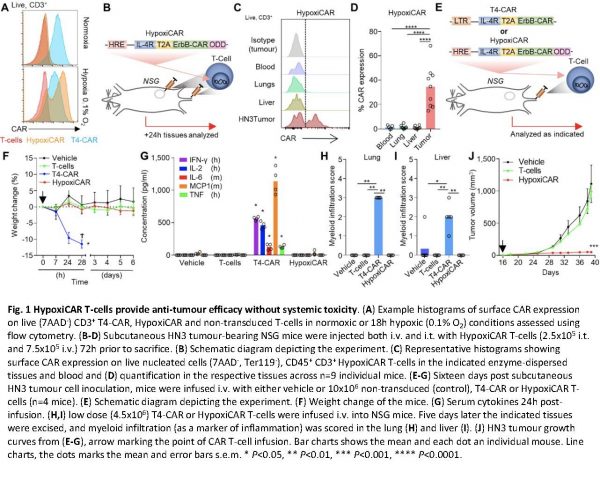Translational development of novel hypoxia-sensing chimeric antigen receptor T cells for avoidance of exhaustion and toxicity
Primary supervisor: James Arnold, King’s College London
Secondary supervisor: John Anderson, UCL
Tertiary supervisor: John Maher, King’s College London
Project
Chimeric antigen receptor (CAR) T-cell immunotherapy has delivered unprecedented clinical outcomes in their use against liquid cancers, but translation of this success to solid malignancies has proven challenging. In an attempt to tackle this issue, this project will combine recent advances in CAR T-cell biotechnology across KCL and UCL to generate a new enhanced CAR T cell approach with the aim to improve T-cell infiltration, enhanced survival and anti-tumour efficacy in the tumour micro environment (TME). The project will explore the use of a CAR targeted against the B7H3 antigen which will be equipped with a newly developed dual oxygen-sensing safety switch to restrict CAR expression to the hypoxic TME of solid malignancies, coined ‘HypoxiCAR’ (Cell Reports Medicine 2021; Figure 1). HypoxiCAR provides a strategy to avoid on-target off-tumour activation which can result in dose and treatment limiting cytokine release syndrome which can be potentially fatal. This project will also investigate novel ways to ‘amour’ the CAR construct to improve the T-cell survival and boost its anti-tumour efficacy. The project will also investigate the optimal cellular carrier of the CAR construct where both gamma-delta (γδ) and alpha-beta (αβ) T-cell populations will be investigated for their respective therapeutic efficacy and persistence in vitro and in vivo. The generation of a successful CAR would represent a next generation candidate for clinical translation.
Aim 1: What is the optimal CAR design and armouring approach?
Explore in vitro a variety of ‘next generation’ anti-B7H3 HypoxiCAR designs using artificial conditions of hypoxia to explore their phenotype, effector function and killing capacity.
Aim 2: What is the optimal lymphocyte carrier for the CAR and which lymphocytes are most efficient at entering hypoxic tumour regions?
Investigate lymphocyte infiltration into hypoxic regions of a variety of human cancers and spatially resolve these cell populations and their prevalence. These images will be analysed using unsupervised computational spatial profiling which will involve short training placement at the Crick Institute.
Aim 3: What is the anti-tumour efficacy and persistence of the developed CAR?
The in vivo anti-tumour efficacy of B7H3 HypoxiCARs (both γδ and αβ T cells) will be explored in a variety of tumour models. The infiltration of the CAR T-cells into the tumour and persistence will be benchmarked against parental versions of the CAR. The CAR T-cells that have infiltrated the tumour will be extracted for flow cytometry phenotyping analysis and sorted for single cell RNA sequencing (scRNAseq) to understand how their phenotype changes and responds in the TME.
This project will utilise the following techniques: Cloning, primary cell culture, killing assays, in vivo models, flow cytometry, confocal microscopy (human and mouse tumour tissues), scRNAseq, computational approaches to spatial cell profiling.

Candidate background
The project would be suitable for a clinician with a background in immunology and/or biomedical sciences. An interest in tumour immunology and immunotherapy is vital.
Potential Research Placements
- John Maher, CAR Mechanics Group, King’s College London
- Francesca Ciccarelli, King’s College London/ Francis Crick Institute
References
- Kosti, P Larios-Martinez, K.I., Maher, J., Arnold, J.N. (2021) Generation of Hypoxia-Sensing CAR T cells. STAR Protocols. 7:100723
- Kosti, P., Opzoomer, J.W., Larios-Martinez, K., Henley-Smith, R., Scudamore, C.L., Okesola, M, Taher, M.Y.M., Davies, D.M., Muliaditan, T., Larcombe-Young, D., Woodman, N., Gillett, C.E., M., Thavaraj, S., Maher, J. and Arnold, J.N. (2020) Hypoxia-sensing CAR t-cells provide safety and efficacy in treating solid tumors. Cell Reports Medicine. 12:658315
- Kosti, P., Maher, J., Arnold, J.N. (2018) Perspectives on chimeric antigen receptor T-cell immunotherapy for solid tumors. Frontiers in Immunology, 22:1104
- Straathof, K. et al. Antitumor activity without on-target off-tumor toxicity of GD2-chimeric antigen receptor T cells in patients with neuroblastoma. Sci Transl Med 12, eabd6169 (2020). Anderson and Pule co-senior authors.
- Fisher, J. et al. Engineering γδT cells limits tonic signaling associated with chimeric antigen receptors. Sci Signal 12, eaax1872 (2019). Anderson and Pe?er co-senior authors
